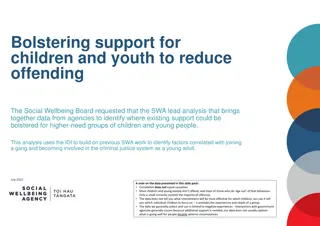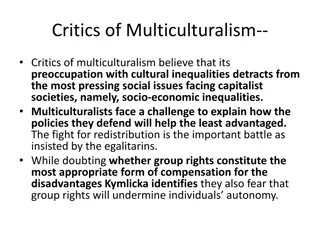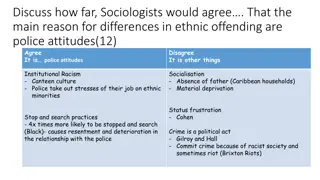Cross-National & Cross-Cultural Risk Factors for Offending
Explore key risk factors for offending across nations & cultures, analyzing homicide rates, structural differences, individual/family factors, and the generalizability of crime risk factors. Learn about findings related to impulsivity, achievement, conduct problems, family supervision, parenting styles, and community socioeconomic status. Demographic comparisons highlight similarities and differences in risk factors among different racial/ethnic groups.
Download Presentation

Please find below an Image/Link to download the presentation.
The content on the website is provided AS IS for your information and personal use only. It may not be sold, licensed, or shared on other websites without obtaining consent from the author.If you encounter any issues during the download, it is possible that the publisher has removed the file from their server.
You are allowed to download the files provided on this website for personal or commercial use, subject to the condition that they are used lawfully. All files are the property of their respective owners.
The content on the website is provided AS IS for your information and personal use only. It may not be sold, licensed, or shared on other websites without obtaining consent from the author.
E N D
Presentation Transcript
Key Cross-National and Cross- Cultural Risk Factors for Offending Alex R. Piquero, Ph.D. Ashbel Smith Professor of Criminology Associate Dean of Graduate Programs, EPPS The University of Texas at Dallas Future of Violence and Its Prevention in Latin America Conference, April 11, 2018
A Peek at Homicide Rates Homicide Rate 120 100 80 60 40 20 0 Los Caracas, Venezuela Acapulco, Mexico Natal, Brazil St. Louis, Missouri San Cali, Dallas, Texas Phoenix, Arizona Cabos, Mexico Salvador, El Salvador Columbia Homicide Rate 120 100 80 60 40 20 0 El Honduras Venezuela US Virgin Jamaica Trinidad and Tobago Brazil Mexico United States Salvador Islands
Big Differences Lead to a search for what types of risk factors may be leading to such distinctive trends. Structural differences Poverty, gangs, drugs, health/nutrition Individual and family differences Family composition, schooling, self-control
Background Much research on main risk factors of delinquency. Two limitations of this research 1. Lack of attention to racial/ethnic differences in offending. 2. Samples of non-offenders and general population.
Generalizability of Risk Factors for Crime Most research focused on studies in high- income countries (HIC), such as the United States, Great Britain, Canada, and Australia. Much of this research has focused mainly on longitudinal studies of males, even fewer studies with females, and almost no comparisons across race/ethnicity, nations, and/or cultures.
Key HIC Risk Factor Findings Individual-level Impulsivity Low achievement Conduct problems Family-level Poor supervision Authoritative parenting Parental criminal/drug history Community-level Low socioeconomic status/poverty
Demographic Comparisons: Race/Ethnicity More similarities than differences between whites and blacks, though level of risk factor tends to be higher among blacks than whites. Key difference is the community-level risk factor of concentrated poverty much more salient for blacks. In the few studies that compare Hispanics to whites and blacks, more similarities than differences, though some unique risk factors for Hispanics: Assimilation and acculturation (the two culture issue).
Demographic Comparisons: Immigrants vs. Native-Born Almost no studies compare correlates of offending between Native-Born and first and second-generation immigrants. My research with Pathways to Desistance Study (serious juvenile offenders in Phoenix and Philadelphia). Results show that first generation immigrants are less likely to be involved in serious offending and appear to desist much more quickly than their peers. Low assimilation (high ethnic identity) and neighborhood disadvantage operate in unique ways across generational status and relate to different offending styles with offending highest for second-generation youth.
Demographic Comparisons: Sex Surprisingly few longitudinal studies examining sex differences in risk factors for offending. Existing studies show many similarities, including impulsivity, poor parenting, delinquent peers. Studies pointing to differences indicate that females experience more (sexual) abuse and exposure to older male youth increases females risk of offending and victimization.
What about country to country comparisons? Very few studies directly compare between countries. One set of studies examined risk factors for offending in Seattle, WA (USA) and Osaka (Japan). Findings showed strong similarities in ranking of risk factors: high risk taking, low parental monitoring, and troubled peers. Another set of studies compared birth cohorts in Brazil and Britain. Findings showed strong similarities in risk factors: hyperactivity and conduct disorder.
What about Low-/Middle- Income Countries? Defined by The World Bank as having low income (LI: those with a GNI per capita of >$1,005; LMI: $1,006 - $3,955 (high income $12,236+). Often referred to as developing countries. Several Latin American countries are LMIC: Bolivia, El Salvador, Guatemala, Honduras, Nicaragua. 75-80% of the world s population live in LMICs.
Risk Factors in LMICs Comparison of risk factors for crime using country-specific investigations. Many of the same risk factors for crime that emerge in HICs also emerge in LMICs: Prior aggression, poor self-control, authoritarian parenting, maternal smoking during pregnancy. Some unique differences including: Exposure to more extreme disadvantage in: socioeconomic status, educational attainment, health/nutrition. These exacerbate the individual- and family-level risk factors. Cultural/context-specific correlates: assimilation, ethnic identity, acculturation, different types of parenting styles more accepted in certain cultures (China, Latin America), civil conflict, and migration.
Research and Policy Needs Research Cross-national and cross- cultural longitudinal studies using many of the same measures, but also using some key context- specific measures. Pay attention to how structural factors may influence contextual, familial, and individual factors (drug trade, extreme poverty, child labor). Policy Many of the same risk factors are translational around the world. Focus prevention and intervention strategies early in life. Early family/child-training programs show strong international effectiveness.























